The SSD Relapse: Understanding and Choosing the Best SSD
by Anand Lal Shimpi on August 30, 2009 12:00 AM EST- Posted in
- Storage
Overall System Performance using PCMark Vantage
Next up is PCMark Vantage, another system-wide performance suite. For those of you who aren’t familiar with PCMark Vantage, it ends up being the most real-world-like hard drive test I can come up with. It runs things like application launches, file searches, web browsing, contacts searching, video playback, photo editing and other completely mundane but real-world tasks. I’ve described the benchmark in great detail before but if you’d like to read up on what it does in particular, take a look at Futuremark’s whitepaper on the benchmark; it’s not perfect, but it’s good enough to be a member of a comprehensive storage benchmark suite. Any performance impacts here would most likely be reflected in the real world.
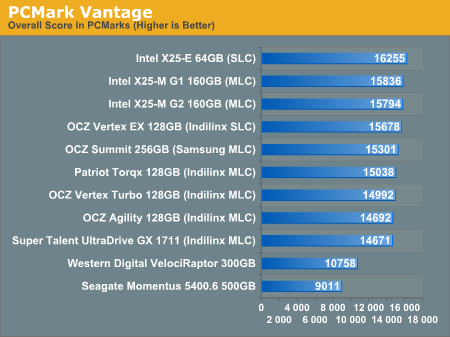
The overall PCMark Vantage score takes into account CPU and GPU performance and thus storage performance is only one aspect of determining your score. All of the SSDs do well here, the slowest configuration still around 36% faster than the WD VelociRaptor; something I'd say is more than reflected in real world performance.
The memories suite includes a test involving importing pictures into Windows Photo Gallery and editing them, a fairly benign task that easily falls into the category of being very influenced by disk performance.
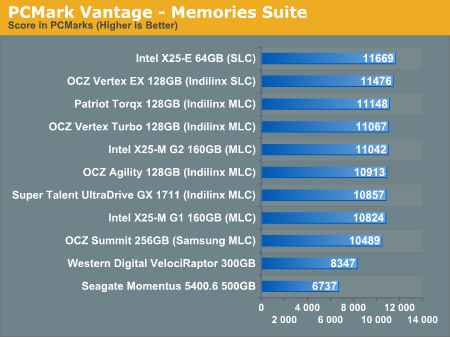
Once again the SSDs all perform very similarly here. The fastest of the group is Intel's X25-E, but the Indilinx drives actually hold the next three spots followed by the new G2. The performance range is very small between these drives though, you honestly can't go wrong with either an Indilinx MLC or X25-M.
The TV and Movies tests focus on on video transcoding which is mostly CPU bound, but one of the tests involves Windows Media Center which tends to be disk bound.
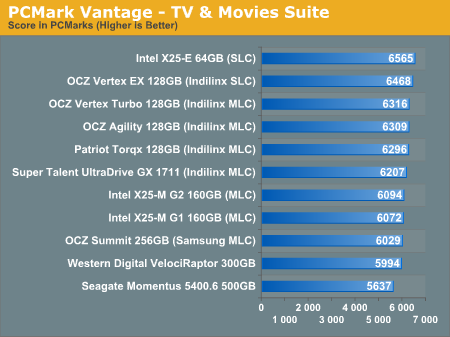
The standings continue to be roughly the same. We see just how much more competitive Indilinx is this time around than when the OCZ Vertex first hit the streets. We do have a real alternative to Intel.
The gaming tests are very well suited to SSDs since they spend a good portion of their time focusing on reading textures and loading level data. All of the SSDs dominate here, but as you'll see later on in my gaming tests the benefits of an SSD really vary depending on the game. Take these results as a best case scenario of what can happen, not the norm.
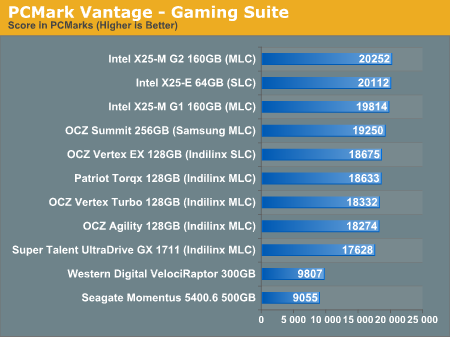
The Vantage Gaming Suite shows us our first example of the X25-M G2 pulling ahead of even the SLC X25-E. Even the Samsung based OCZ Summit does very well here.
In the Music suite the main test is a multitasking scenario: the test simulates surfing the web in IE7, transcoding an audio file and adding music to Windows Media Player (the most disk intensive portion of the test).
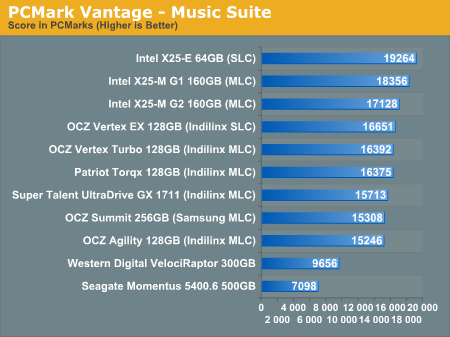
The Intel drives are at the top, the G1 faster than the G2, followed by the Indilinx drives, then the Samsung drive and the mechanical drives. New performance is important here because once TRIM shows up, this is closer to what you'll be seeing for a drive with a good amount of free space.
The Communications suite is made up of two tests, both involving light multitasking. The first test simulates data encryption/decryption while running message rules in Windows Mail. The second test simulates web surfing (including opening/closing tabs) in IE7, data decryption and running Windows Defender.
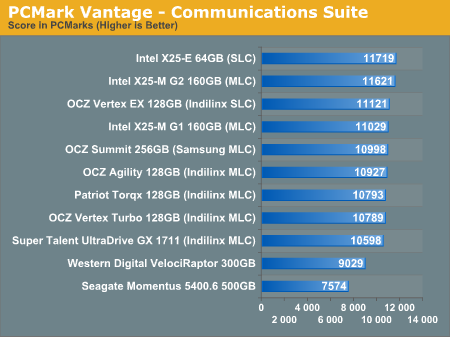
I love PCMark's Productivity test; in this test there are four tasks going on at once, searching through Windows contacts, searching through Windows Mail, browsing multiple webpages in IE7 and loading applications. This is as real world of a scenario as you get and it happens to be representative of one of the most frustrating HDD usage models - trying to do multiple things at once. There's nothing more annoying than trying to launch a simple application while you're doing other things in the background and have the load take seemingly forever.
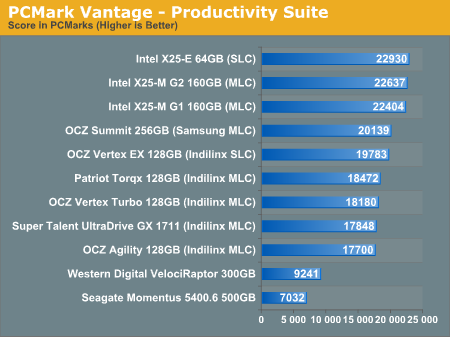
Here the Intel drives are at the top, by a noticeable margin. The G1, G2 and X25-E are all around the same level of performance. Samsung comes close with the OCZ Summit and the Indilinx drives pull up the rear. You can't go wrong with either the Intel or Indilinx drives but Intel is clearly faster here.
The final PCMark Vantage suite is HDD specific and this is where you'll see the biggest differences between the drives:
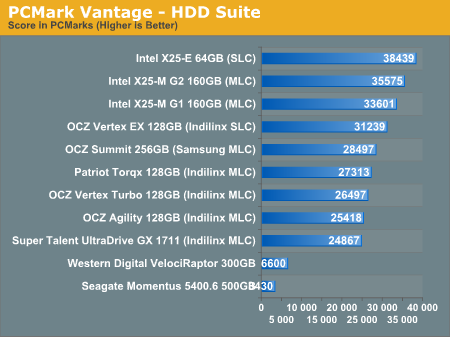
When it comes to pure drive performance, the breakdown doesn't get any simpler. Intel's X25-E holds the top spot, followed by the G2 and G1. While the G2 is only 5.6% faster than the G1, remember that we're looking at "new" performance here. Over time, with TRIM, the G2 will be closer to this performance, while the G1 will never get here again.
Despite poor random small file write performance, the OCZ Summit actually does very well here.
All of the drives perform incredibly compared to any mechanical hard drives.










295 Comments
View All Comments
Mr Perfect - Tuesday, September 1, 2009 - link
Probably demand. When I saw that price, I shopped around to see what was going on. Answer? Everyone else seems to be out of stock.Naccah - Tuesday, September 1, 2009 - link
I've been waiting to get an SSD till Win 7 released hoping that the prices would have stabilized somewhat by that time. The recent price fluctuation is disturbing as well as the availability of the X25 G2. When the G2 first hit Newegg I was surfing the site and could have grabbed one for $230, but like I said I was content to wait. Now I'm having second thoughts! and wondering if I should grab one if the price goes down again.gfody - Tuesday, September 1, 2009 - link
That doesn't explain the 160gb - it's not even in stock yet. I have been waiting a month for this drive to be in stock and here they more than double the price one day before the ETA date! It's an outrage.. if I'd known the drive was $1000 I would have bought something else.Way to screw your customers Newegg
araczynski - Tuesday, September 1, 2009 - link
A) your intro has the familiar smell of tomshardware, you'd do to be without that, its unbecoming.B) your final words smell of the typical big corp establishment mentality; bigger, faster, more expensive, consumers want! while if the market is any indication, is completely the opposite of the truth. people want 'good enough' for cheap, as the recent Wired magazine article more or less said. granted, Wired isn't the source for indepth technical reading, but it is a good source sometimes of getting the pulse of things...sometimes, still, more often than anything coming out of the mouths of the big corps.
C) everything in between A and B is great though :) Please leave the opinions/spins to the PR machines.
Personally, the cost of these things is still more than i'm willing to pay for, for any speed increase. the idiotic shenanigans of firmwares and features only present after special downloads/phases of the moon make me just blow off the whole technology for a few more years. I'll revisit this in say 2 or 3 years, perhaps the MLC's will finally die off and the SLC's (unless i have the 2 backwards) or something better rolls out with a longer lifespan.
Anand Lal Shimpi - Tuesday, September 1, 2009 - link
A) My intention with the intro was to convey how difficult it was for me to even get to the point where I felt remotely comfortable publishing this article. I don't like posting something that I don't feel is worthy of the readership's reception. My sincere apologies if it came off as arrogant or anything other than an honest expression of how difficult it was to complete. I was simply trying to bring you all behind the scenes and take you into the crazy place that's my mind for a bit :)B) I agree that good enough for cheap is important, hence my Indilinx recommendation at the end. But we can't stifle innovation. We need bigger, better, faster (but not necessarily more expensive, thank you Moore's Law) to keep improving. I remember when the P3 hit 1GHz and everyone said we don't need faster CPUs. If we stopped back then we wouldn't have the apps/web we have today since developers can count on a large install base of very fast processors.
Imagine what happens in another decade when everyone has many-core CPUs in their notebooks...
Take care,
Anand
DynacomDave - Tuesday, September 29, 2009 - link
First - Anand thanks for the good work and the great article.I too have an older laptop that has a PATA interface that I'd like to upgrade with an SSD. I contacted Super Talent about their MasterDrive EX2 - IDE/PATA. Their response was; We only use Indilinx controller for SATA drives, like UltraDrive series. We use Phison controller for EX2/IDE drives.
I want to improve performance not degrade it. I don't know if this will perform like the Indilinx or like the old SSDs. Can anyone help me with this?
bji - Tuesday, September 1, 2009 - link
There are a few more smaller players in the SSD controller game that don't ever show up in these reviews. They are Silicon Motion and Mtron. The reason I am interested in them is because I have a laptop that is PATA only (it's old I know but I love it and I want to extend its life with an SSD), and I am trying to get an SSD that works in it.Turns out the Mtron MOBI SSDs are not compatible with this laptop. I have no idea why. So I have put an order into eBay for an SSDFactory SSD and am crossing my fingers that it will work.
Mtron makes SATA SSD drives so they could be included in these reviews, and I don't know why they are excluded. It would be interesting to see how their controllers stack up. I personally own two Mtron SSD drives (both 32 GB SLC drives) that I tried to get to work in my laptop and failed to - so one is now the system disk in my desktop and it is very fast (at least compared to platter drives, maybe not compared to newer SSDs). The other one I am still trying to find a use for.
The only Silicon Motion controller drives I have seen are PATA drives so they clearly are a different beast than the SATA drives typically reviewed in these articles. But I would still be interested in seeing the numbers for the Silicon Motion controller just to get an idea of how well they stack up against the other controllers, especially for the 4K random writes tests. The PATA interface ought not to be the limiting factor for that test at least.
paesan - Tuesday, September 1, 2009 - link
I see NewEgg has a Patriot Troqx and a Patriot Torqx M28. What is the difference in the 2 drives.paesan - Tuesday, September 1, 2009 - link
After reading thru the Patriot forum I found the differences. The M28 has 128MB cache compared to 64MB cache on the non M28. The biggest difference is the M28 uses a Samsung controller instead of the Indilinx controller on the non M28. I wonder why they switched controllers.valnar - Tuesday, September 1, 2009 - link
It seems to be that using trim would make a "used" SSD faster, no doubt, but is it required? Would it be okay to buy an SSD for a Windows XP box and just set and forget it? Even used and fragmented, it appears to be faster than any hard drive. My second question is longevity. How long would one last compared to a hard drive?